
Organisations gain many different operational benefits from producing goods or providing services on a large scale. As they get larger, often through the integration of business units under a single umbrella company, average unit costs fall and they benefit from economies of scale.
Organisations must, however, aim for an optimum size of production, i.e. the size which suits them best. If the optimum size of an organisation is exceeded, the business becomes difficult to manage and inefficiencies, known as diseconomies of scale, occur.
The competitive climate in which organisations operate changes constantly and therefore businesses should frequently evaluate their size to decide on a scale appropriate to the current markets in which they operate. This case study focuses on the challenges facing Lucent Technologies, following its demerger, announced in September 1995, from AT&T.
Lucent Technologies was born out of one of the most shocking announcements in American corporate history. In 1995, AT&T, then one of the world’s largest companies, presented a plan to split itself into three. At that time, AT&T had businesses in 200 countries, and operated the world’s largest telecommunications (telephone) network, handling over 190 million calls daily. It stood as a world-wide corporate phenomenon – the vertically integrated corporation – manufacturing goods and providing services at different stages of production. It owned Bell Laboratories, one of the world’s largest and most highly-respected research laboratories.
So why should a large successful business decide that it needed to go through a demerger? After all, as AT&T, the company was reaping the benefits of many economies of scale, providing services such as long-distance telephony, products from microchips to personal computers and bank cash machines, and equipment such as telephone exchanges and transmission equipment.
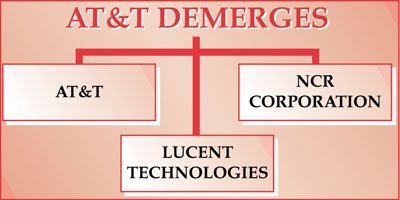
The answer is that the complexity of managing all the different parts of the business was beginning to overwhelm the advantages of integration. Any business organisation must be responsive and flexible in order to best meet changing market needs. The aim of demerging to create Lucent was to resolve the internal conflicts which had sprung up within AT&T, and produce a company which could react quickly and take advantage of business opportunities.
The demerger was the world’s largest ever corporate split-up. It represented a bold plan which fundamentally changed an industrial giant to create three smaller, more focused organisations. The three resulting companies were:
- Lucent Technologies (including Bell Laboratories)
- A communications services company which retained the AT&T name and logo
- A business computing company which changed its name in 1996 to NCR Corporation.
New start-up company

Lucent Technologies designs, develops, manufactures and markets communication systems and technologies, ranging from microchips to whole networks. It became a fully independent company on April 4th 1996 when its shares were publicly traded on the New York Stock Exchange. At the end of the first day of trading, $3 billion worth of shares had been sold – the largest initial public offering in American history.
One of the earliest challenges for any new company is selecting a name and corporate identity for the new corporate business. The name ‘Lucent Technologies’ was chosen for several reasons. Lucent means ‘glowing with light’ and ‘clarity of vision’. This provides strong, positive images which are appropriate for an innovative and energetic company. The red symbol, the innovation ring, is hand-drawn and represents human innovation.
The starting point for any newly formed organisation is to set out what it wants to achieve. A mission is an overriding statement in line with the expectations of shareholders. Lucent’s mission is ‘to provide customers with the world’s best and most innovative communication systems, products, technologies and customer support. Powered by excellent people and technology, we will strive to be a customer-driven, high performance company that delivers superior, sustained shareholder value.’
Values help to provide more of a focus for action and show how the organisation wants to satisfy the needs of its customers. Lucent’s values are ‘an obsession with serving our customers: a commitment to business excellence (speed, innovation and quality): a deep respect for the contributions of each person to the success of the team (integrity and candour, mutual respect, teamwork and personal accountability): a strong sense of social responsibility.’ Lucent demonstrates these values in an acronym – GROWS.
G Global growth
R Results focused
O Obsession with customers and competitors
W Workplace that is open to ideas and communication
S Speed
All employees are encouraged to demonstrate these values in their daily work life and outstanding performances are duly rewarded.
Lucent wanted to focus its resources on customers in the fastest growing areas of world-wide markets. Shortly after becoming an independent company, therefore, it announced the business was to be reorganised. The reorganisation helped Lucent to concentrate on areas such as wireless, semiconductors, data networking and optical networking.
A Chief Executive Officer and two new Chief Operating Officers were appointed to support the newly-organised business and eleven new business units were formed, ten of which are present in the UK. Unusually for a US-based company, one of the Chief Operating Officers is a European. Through reorganisation, Lucent has become a group of eleven businesses tightly focused on customers, markets and competitors.
The new business structure
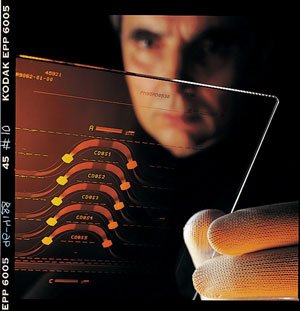
It was important to provide each of the newly-reorganised business units with direction.
In order to build Lucent Technologies into a customer-focused business, each of the newly-created businesses have been set up to serve different market segments. These include:
- The Microelectronics Group which includes current microelectronics products, such as integrated circuits and optoelectronics, including lasers and laser receivers.
- Business Communications Systems which builds voice-related products, such as call centres, Internet call centres, voicemail systems and telephone switchboards.
- Data Networking Systems comprising voice and data communications. This is the business that will create a single network to carry voice, video, computer data and Internet traffic.
- Global Service Provider Business unifies Lucent’s customer interface to service provider customers around the world with the global marketing responsibility for Lucent’s largest customer segment. It includes management of Internet and wireless service providers and global commercial markets.
- Wireless Networks Group includes the manufacturing, development and product marketing for wireless products, software and support services. A typical customer would be a mobile phone company.
- Switching and Access Systems Group includes all manufacturing and development of switching and software products for the carrier market.
- Optical Networking Group includes the manufacturing and development for fibre optics.
- Network Products Group develops fibre products and power systems products.
- Communications Software Group includes the development of applications software.
- Intellectual Property Division manages Lucent’s extensive portfolio of intellectual property such as patents.
- New Ventures Group continues to create new ventures and exploit new ideas from Bell Labs.
Growth
Acquisitions
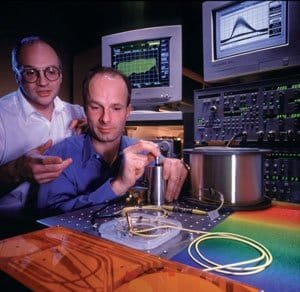
As Lucent focused on growth opportunities, it became possible to strengthen its portfolio of businesses with a number of acquisitions (buying other companies) and business partnerships. However, in order to remain a leader in an industry which is currently undergoing profound change, it will be necessary for Lucent to reassess the portfolio of business offerings continually.
Global growth
Industry analysts predict that the telecommunications market across the world will exceed $250 billion by the year 2000. For Lucent to succeed, therefore, it must capitalise on this new market opportunity outside the United States. Although Lucent is the world’s leading supplier of telecommunications infrastructure equipment, top rivals in the global arena have a long history of doing business around the world.
The new operating units have been developed with a global focus. For example, the Business Communications Systems unit has 1.5 million customers outside the US and is growing by 20% annually outside the US. Across Europe, there are approximately 15,000 employees and 135,000 worldwide. Lucent has offices or distributors in more than 90 countries and territories, including 133 locations in 28 European countries. As a truly global business, therefore, it has to create a culture of winning contracts wherever markets are located. It must develop a global strategy and focus on telecommunication developments worldwide.
The multi-local business
With increasing competition across its markets worldwide, Lucent has adopted a ‘multi-local’ approach to its business. More than 70% of Lucent’s growth potential is outside the United States. To achieve this growth, Lucent employees need to develop a global mindset focusing on better ways to penetrate and serve such markets.
Although Lucent is a large organisation, it must not be restricted by many of the diseconomies which troubled AT&T. It must be able to respond to opportunities to support and supply customers wherever they are in the world. Even though it is a multi-national business, it must develop business opportunities with the response time of a much smaller, local business. This involves focusing on customer needs and requirements wherever they are.
R&D and innovation
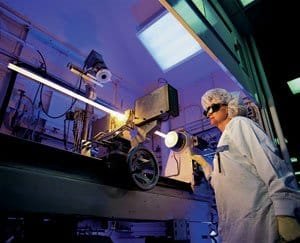
When the demerger took place, Bell Labs separated from AT&T to become the innovation engine for Lucent Technologies. Bell Labs was the birthplace of the transistor, the communications satellite, laser, solar cell, cellular telephony and stereo recording. Bell Labs focuses its research efforts on product developments related to Lucent Technologies’ business. The future of the data communication market promises to be exciting and fast-moving.
The concept of ‘personalised mobility’, i.e. when users can access all forms of data through a variety of fixed and mobile networks using a single terminal, is not so very distant. As technology develops, it is becoming increasingly likely that Bell Labs will be leading the way to make personal mobility a reality.
Bell Labs’ mission is to pioneer new technological developments and help Lucent bring that technology to the market-place. It involves going beyond invention to innovation. Invention is about developing new ideas, whereas innovation involves taking the ideas and doing something useful with them. Bell Labs takes a highly systematic approach to planning – the development of product and technology roadmaps which connect researchers with ‘what’s needed’ to ‘what’s possible’ through sales and marketing. Researchers have become part of the product team and are instrumental in producing and maintaining the product plan.
Research and development
Around 11% of Lucent’s revenues are invested in research and development. Investment in tomorrow’s communications technologies involves converting ideas into patents at a rapid rate (on average more than three every business day!) A patent is a sole right to use an innovation for a period of time. Patents help to protect Lucent’s investment in research and development.
Bell Labs searches for new ways to speed innovations into the market. Its scientists and engineers are constantly working to develop breakthrough technologies and examine how such technologies can be brought to the market quickly.
The new global Bell Labs research and development community is at the heart of Lucent’s creative efforts, bringing innovations and new technologies to all of the new business units within Lucent. As Bell Labs is integrated with Lucent’s businesses, it makes it possible to deliver innovations to customers in the marketplace in record time.
Today, Bell Labs’ experts participate in all parts of Lucent Technologies’ business, from research and development, through to planning, production and marketing. This integration of research and development with each of Lucent’s businesses has helped Bell Labs to focus on the most important technologies. In one of the fastest growing and exciting market-places in the world, rapid time to market is often the difference between becoming a market leader or a market laggard. Recent innovations include:
- Elemedia™ – this is a Lucent venture that is commercialising technology for the delivery of high-quality speech, music and video over the Internet. It is now used in the Netscape Navigator browser.
- Truewave® – this is a special fibre which carries multiple colours of laser light in communication systems, thereby increasing the amount of information in data, sound and images that can be transmitted over networks.
- Scalpel™ – four generations ahead of the current technology for making microchips, this invention will create the tiniest transistors and integrated circuits ever.
Innovations and breakthroughs require the ideas and energies of exceptional people. Bell Labs attracts some of the best scientific and technical minds in the world and Lucent is building its business around them. For example, in March 1998, Lucent demonstrated Terabit transmission – the world’s first long-distance transmission of a trillion bits of data every second. This could allow the entire world’s Internet traffic to be transmitted via a single strand of optical fibre – the Truewave®.
Conclusion
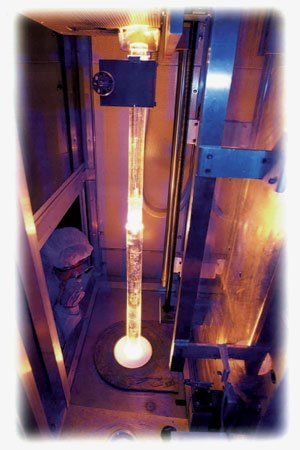
By aligning Bell Labs’ research and technology (as well as technology obtained through acquisitions) more closely with the needs of its customers, Lucent Technologies has been able to bring networking technologies to the market faster than ever before. Lucent Technologies recently announced a doubling of net income and earnings per share, providing significantly more value for its stakeholders.
The company also announced:
- An exclusive contract to build a wireless broadband data network.
- The introduction of the WaveStar™ OLS 400G system delivering five times the capacity of today’s commercial fibre-optic systems.
- The acquisition of Prominet, a leader in Ethernet intelligent networking.
- The launch of WildWire™, a new digital subscriber line system.
Energised by Bell Labs’ research and development unit, Lucent has empowered its diverse and global workforce to take advantage of business opportunities and become a leader in serving its customers. The split from AT&T and the response to the challenges that this posed has enabled Lucent to grow parts of the business at record levels and strengthen the company for future growth.
The eleven newly-created, customer-focused businesses benefit from Bell Labs’ innovations and technological expertise. At the same time, the name Lucent Technologies provides a single face for customers externally so that today, Lucent is a group of responsive and flexible companies, tightly focused on customers and markets, facilitated through the demerger of an industrial giant.
